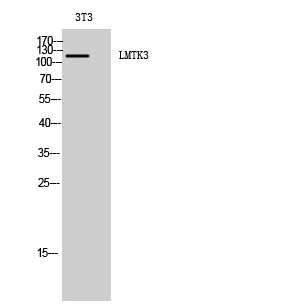
| WB | 咨询技术 | Human,Mouse,Rat |
| IF | 咨询技术 | Human,Mouse,Rat |
| IHC | 1/100-1/300 | Human,Mouse,Rat |
| ICC | 技术咨询 | Human,Mouse,Rat |
| FCM | 咨询技术 | Human,Mouse,Rat |
| Elisa | 1/20000 | Human,Mouse,Rat |
| Aliases | LMTK3; KIAA1883; TYKLM3; Serine/threonine-protein kinase LMTK3; Lemur tyrosine kinase 3 |
| Entrez GeneID | 114783; |
| WB Predicted band size | 40kDa |
| Host/Isotype | Rabbit IgG |
| Antibody Type | Primary antibody |
| Storage | Store at 4°C short term. Aliquot and store at -20°C long term. Avoid freeze/thaw cycles. |
| Species Reactivity | Human,Mouse |
| Immunogen | Synthesized peptide derived from the C-terminal region of human LMTK3. |
| Formulation | Purified antibody in PBS with 0.05% sodium azide,0.5%BSA and 50% glycerol. |
+ +
以下是关于LMTK3抗体的3篇参考文献的简要信息:
---
1. **文献名称**: *LMTK3 confers oncogenic growth and resistance to tamoxifen in breast cancer*
**作者**: Giamas G. et al.
**摘要**: 该研究揭示了LMTK3在乳腺癌中通过调控雌激素受体α(ERα)稳定性促进肿瘤生长的作用,并开发了特异性LMTK3抗体用于检测其在乳腺癌组织中的表达水平,证实其高表达与患者预后不良相关。
---
2. **文献名称**: *LMTK3 is a novel biomarker and therapeutic target in colorectal cancer*
**作者**: Stebbing J. et al.
**摘要**: 研究团队利用LMTK3特异性抗体进行免疫组化分析,发现LMTK3在结直肠癌中过表达且与肿瘤侵袭性相关,进一步通过功能实验证明其通过Wnt/β-catenin通路促进转移,提示其作为治疗靶点的潜力。
---
3. **文献名称**: *Proteomic characterization of LMTK3 signaling in kinase networks*
**作者**: Sergina N. et al.
**摘要**: 通过LMTK3抗体进行免疫共沉淀和质谱分析,揭示了LMTK3与多种激酶(如AKT、ERK)的相互作用网络,阐明其在细胞增殖和凋亡抵抗中的调控机制,为靶向干预提供理论基础。
---
如需具体文献来源或更多细节,建议通过PubMed或Web of Science检索上述作者及关键词。
LMTK3 (Lemur tyrosine kinase 3) is a member of the lemur kinase family, a group of poorly characterized transmembrane kinases with roles in cellular signaling and disease. Initially identified in 2005. LMTK3 has gained attention for its involvement in cancer progression, particularly in hormone receptor-positive breast cancer, gastric cancer, and lung adenocarcinoma. Structurally, LMTK3 contains an N-terminal transmembrane domain and a C-terminal tyrosine kinase-like domain, though its catalytic activity remains debated due to atypical kinase motifs.
Functionally, LMTK3 regulates multiple oncogenic pathways, including estrogen receptor α (ERα) signaling via interactions with protein phosphatase 1 (PP1) and 14-3-3 proteins. It promotes cancer cell proliferation, metastasis, and therapy resistance by modulating key targets like GSK-3β, β-catenin, and G3BP2. Elevated LMTK3 expression correlates with poor prognosis in various cancers, making it a potential therapeutic target.
LMTK3 antibodies are critical tools for studying its expression, localization, and molecular interactions. They enable detection in tissues and cell lines through techniques like Western blot, immunohistochemistry, and immunofluorescence. Some antibodies target specific domains to investigate kinase activity or post-translational modifications. Recent studies also explore LMTK3-neutralizing antibodies as experimental therapeutics to block oncogenic signaling. However, challenges remain in validating antibody specificity due to structural similarities with other lemur kinases. Ongoing research aims to refine antibody-based applications for both basic research and clinical translation.
×